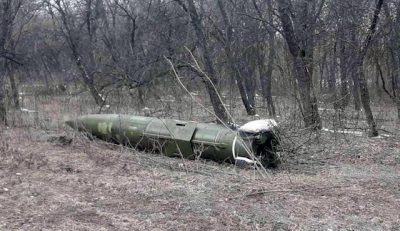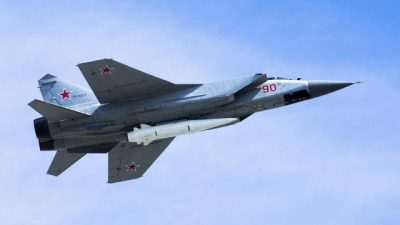What are hypersonic missiles? Russia’s newest weapon in Ukraine war
Russia’s military has claimed to have twice unleashed hypersonic missiles in its invasion of Ukraine, apparently destroying an arms depot in the process, during its monthlong onslaught.
On Saturday, the Russian Ministry of Defense claimed it had struck an underground missile and ammunition warehouse in a village that borders Romania, and on Sunday, that it had destroyed a fuel depot near the southern city of Mykolaiv.
Defense Ministry spokesperson Igor Konashenkov claimed the attack used its newest Kinzhal, or “dagger,” hypersonic missile, in Ukraine.
“The Kinzhal aviation missile system with hypersonic aeroballistic missiles destroyed a large underground warehouse containing missiles and aviation ammunition in the village of Deliatyn in the Ivano-Frankivsk region,” Konashenkov claimed.
RIA Novosti, a Russian state news agency, said the attacks were the first time the next-generation weapons have been used since Russian troops were deployed to Ukraine on Feb. 24.
However, on March 9, Ukraine’s National Guard shared a picture of an unexploded hypersonic missile in the city of Kramatorsk in the breakaway region of Donetsk. Reports did not verify whether it was a “dagger” missile.

‘Ideal weapon’
The advanced missile, which Russian President Vladimir Putin previously described as an “ideal weapon,” was one of several new weapons he unveiled in his state of the nation address in 2018. During that speech, Putin boasted that the missiles could hit almost any point across the world and evade the United States’ missile defense shield.
It is believed that Russia first used the hypersonic weapon in support of Bashar Assad during the Syrian civil war in 2016, although it has not been confirmed if it was the exact Kinzhal model.
The missile, designed to be launched from a MiG fighter jet, can fly at 10 times the speed of sound, and unlike other missiles can change course during its flight, making it impossible for air-defense systems to shoot it down. The Kinzhal missile can also be used to deliver nuclear weapons.
In comparison, while the U.S. Tomahawk cruise missile can travel as fast as 550 mph, the Kinzhal can travel at 7,672 mph. The French Navy and the U.K.’s Royal Navy have since 2011 been jointly developing their own hypersonic missile, which is expected to be completed in 2030.
Ukrainian officials have confirmed Russia’s attacks over the weekend but said the type of missile used was not confirmed.
Unconfirmed reports

According to reports, doubts have swirled over Russia’s use of the ballistic missile. One report suggested that the lack of secondary explosions from the attack at an ammunition warehouse in western Ukraine is suspicious. “There’s also a distinct lack of secondary explosions as one would expect when rocket fuel and explosives cook-off,” the online magazine the War Zone noted on Saturday.
The magazine also questioned how an Orlan-10 — an unmanned aerial vehicle, commonly known as a drone — was able to fly over the targeted area to film the strike. If a maneuverable hypersonic missile was needed for the attack due to Ukraine’s air-defense systems, then how could a drone manage to film the strike and get away safely?
Russian analyst Pavel Felgenhauer said the missile would change little on the ground in Ukraine beyond “giving a certain psychological and propaganda effect.” He added that its use may suggest that the Russian military’s weapons are drying up. Defense strategy researcher Joseph Henrotin reiterated Felgenhauer’s point, suggesting on Twitter that Russia could be running out of weaponry. Henrotin also claimed that Putin might have used the nuclear-capable missile in a bid to raise the stakes of the war.
On Saturday, the U.N.’s human rights office said at least 847 civilians had been killed since Feb. 24, including 155 men, 119 women, 21 boys and seven girls, but said it’s believed the actual figures are “considerably higher.”
(Yahoo News)


